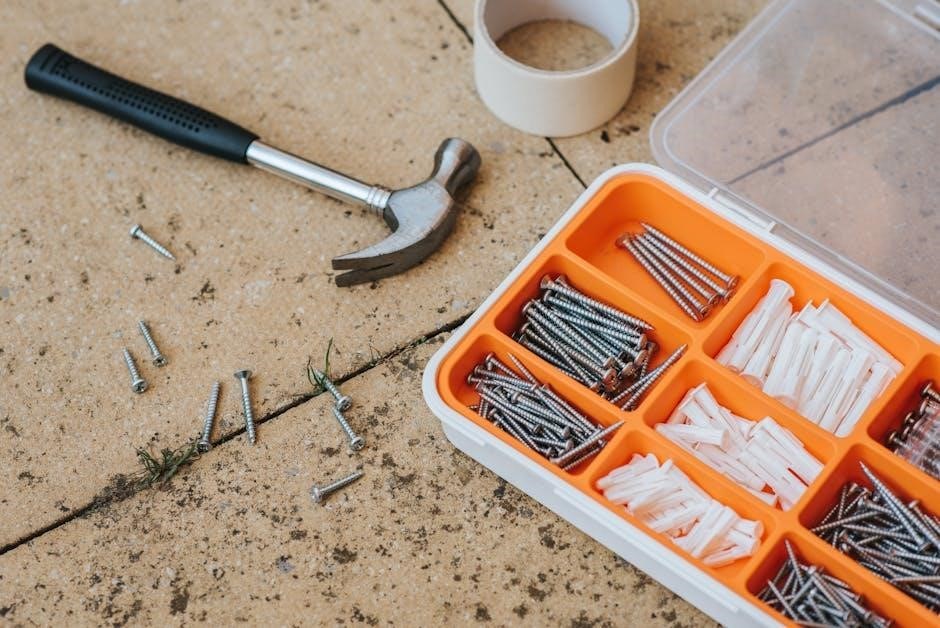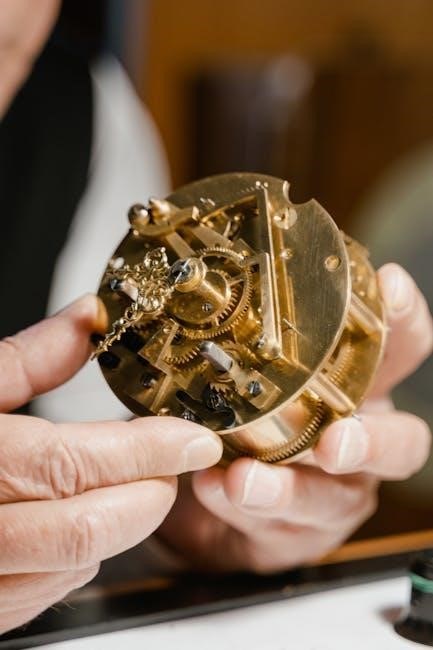
maintenance manual for cessna 172
The Cessna 172 Maintenance Manual is essential for ensuring the aircraft’s airworthiness and safety. It provides detailed procedures for inspection, repair, and compliance with airworthiness directives, serving as a comprehensive guide for owners, mechanics, and pilots to maintain the aircraft’s optimal performance and reliability.
1.1 Purpose and Scope of the Manual
The Cessna 172 Maintenance Manual is designed to provide clear, standardized procedures for maintaining the aircraft. Its purpose is to ensure compliance with airworthiness standards, enhance safety, and prolong the aircraft’s lifespan. The manual covers inspections, repairs, and routine maintenance tasks, offering detailed guidance for owners, mechanics, and operators. It outlines the necessary steps to identify and address potential issues, ensuring the aircraft remains in optimal condition for flight operations.
1.2 Importance of Regular Maintenance
Regular maintenance is critical to ensuring the Cessna 172’s safety, performance, and compliance with airworthiness standards; It prevents mechanical failures, reduces operational risks, and extends the aircraft’s lifespan. Proper maintenance also enhances safety for passengers and crew by identifying and addressing potential issues early. Consistent adherence to maintenance schedules ensures the aircraft remains airworthy and operates efficiently, minimizing downtime and costly repairs while maintaining its value and reliability for years of safe flight operations.
1.3 Safety Precautions and Guidelines
Adhering to safety precautions is paramount when performing maintenance on the Cessna 172. Always wear protective gear, including gloves and safety glasses, and ensure the aircraft is securely grounded; Use approved tools and follow proper lockout/tagout procedures to prevent accidental startup. Consult the manual for specific guidelines, and never deviate from recommended practices. Be mindful of environmental hazards, such as fuel spills, and ensure proper ventilation to avoid fire risks. Safety protocols protect both the aircraft and the technician, ensuring efficient and incident-free maintenance operations.
Types of Maintenance Manuals for Cessna 172
The Cessna 172 maintenance manuals include Service Manuals, Parts Catalogs, Structural Repair Manuals, and supplements, each serving essential roles in aircraft upkeep and compliance.
2.1 Service Manuals
Service Manuals for the Cessna 172 provide detailed maintenance procedures, troubleshooting guides, and repair instructions. They cover routine inspections, engine and fuel system checks, and electrical component diagnostics. These manuals ensure compliance with airworthiness directives and safety standards, offering step-by-step instructions for mechanics and pilots. Regular updates reflect the latest technical advancements, making them indispensable for maintaining the aircraft’s performance and reliability. Adhering to these manuals is crucial for preventing malfunctions and ensuring passenger safety during flights.
2.2 Parts Catalogs
Cessna 172 Parts Catalogs provide a comprehensive list of aircraft components, including part numbers, descriptions, and suppliers. These catalogs are essential for identifying and ordering the correct parts for maintenance and repairs, ensuring compliance with airworthiness standards. They include detailed diagrams and reference materials, making it easier to locate specific components. Regular updates reflect changes in aircraft design and technology, ensuring mechanics and owners have access to the most accurate information for keeping the Cessna 172 operational and safe.
2.3 Structural Repair Manuals
Cessna 172 Structural Repair Manuals detail procedures for repairing aircraft structures, ensuring airworthiness. They include guidelines for skin repairs, access hole cutting, and material specifications. These manuals provide step-by-step instructions for addressing damage, from minor dents to complex rebuilds. They also outline safety protocols and best practices to maintain structural integrity, crucial for both routine inspections and major overhauls. Regular updates ensure compliance with the latest aviation standards.

Routine Maintenance Procedures
Routine maintenance for the Cessna 172 includes pre-flight inspections, engine checks, and system evaluations to ensure safety and efficiency. Regular tasks are outlined in the manual.
3.1 Pre-Flight and Post-Flight Inspections
Pre-flight and post-flight inspections are critical for ensuring the Cessna 172’s airworthiness and safety. These checks involve verifying control surfaces, inspecting for oil or fuel leaks, and ensuring all systems function properly. Pilots must follow the manual’s guidelines to identify potential issues early, such as damage or wear on tires, brakes, and propellers. Post-flight inspections also include securing the aircraft and documenting any findings for maintenance records, ensuring compliance with safety standards and preventing unforeseen operational risks.
3.2 Engine and Propeller Maintenance
Regular engine and propeller maintenance is vital for the Cessna 172’s performance and safety. Inspections should include checking for oil leaks, wear on propeller blades, and proper engine compartment cleanliness. The manual outlines procedures for routine maintenance, such as monitoring oil levels and ensuring propeller pitch settings are correct. Adhering to these guidelines helps prevent engine failure, ensures smooth operation, and extends the lifespan of critical components, maintaining the aircraft’s reliability and efficiency during flight operations.
3.3 Fuel and Hydraulic System Checks
Fuel and hydraulic system checks are critical for ensuring safe and efficient aircraft operation. The manual specifies procedures for inspecting fuel tanks, lines, and connections for leaks or damage. Hydraulic systems, including brakes and landing gear, must be tested for proper function and pressure. Regular draining of fuel samples ensures contamination-free fuel, while adherence to maintenance schedules prevents system failures. These checks are essential for maintaining aircraft performance, safety, and compliance with airworthiness standards.

Compliance with Airworthiness Directives (ADs)
Compliance with Airworthiness Directives (ADs) is crucial for maintaining the Cessna 172’s safety and regulatory compliance. ADs outline mandatory modifications, inspections, or repairs to ensure airworthiness; Service Bulletins (SBs) provide additional guidance, while proper documentation ensures traceability and accountability in adherence to aviation standards.
4.1 Understanding ADs and Their Impact
Airworthiness Directives (ADs) are mandatory instructions issued by aviation authorities to address safety concerns or defects in aircraft design or operation. Compliance ensures the Cessna 172 remains airworthy and safe. ADs often require specific inspections, modifications, or repairs within a defined timeframe. Failure to comply can result in legal penalties and operational restrictions. Service Bulletins (SBs) may provide additional guidance but are not mandatory like ADs. Understanding and adhering to ADs is critical for maintaining safety and regulatory compliance. Proper documentation is essential for tracking compliance and ensuring accountability.
4.2 Service Bulletins (SBs) and Their Role
Service Bulletins (SBs) are non-mandatory recommendations issued by Cessna to address specific maintenance, repair, or modification tasks. They aim to enhance safety, performance, or compliance with regulations. Unlike Airworthiness Directives, SBs are optional but often recommended to ensure optimal aircraft condition. They provide detailed instructions, parts information, and maintenance tips, helping owners and mechanics maintain the Cessna 172’s reliability and efficiency. Adhering to SBs is considered best practice for proactive maintenance and long-term aircraft health.
4.3 Record-Keeping and Documentation
Accurate and detailed record-keeping is crucial for maintaining compliance with airworthiness standards. The Cessna 172 maintenance manual emphasizes documenting all inspections, repairs, and compliance with Airworthiness Directives (ADs) and Service Bulletins (SBs). Proper documentation ensures traceability of maintenance actions and facilitates audits. Records should include dates, procedures performed, and personnel involved. Digital tools, such as the Veryon Publications mobile app, can streamline record management, ensuring accessibility and organization for future reference and regulatory compliance.

Troubleshooting Common Issues
Troubleshooting common issues in the Cessna 172 involves identifying and addressing problems like oil leaks and electrical malfunctions. The maintenance manual provides guidelines to ensure timely and effective resolutions, maintaining aircraft reliability and safety.
5.1 Identifying and Addressing Oil Leaks
Identifying oil leaks in the Cessna 172 involves regular inspections of engine compartments, hoses, and metal lines. Leaks are often detected during routine maintenance checks, such as every 50 or 100 flight hours. Mechanics should clean the engine and compartment if necessary before inspection. Addressing leaks promptly prevents engine damage and ensures compliance with safety standards. The maintenance manual provides detailed procedures for diagnosing and repairing oil leaks effectively.
5.2 Diagnosing Electrical System Malfunctions
Diagnosing electrical system malfunctions in the Cessna 172 involves checking circuit breakers, voltage levels, and wiring connections. Mechanics should use a multimeter to test electrical components and ensure proper function. The maintenance manual provides detailed troubleshooting steps and repair procedures. Regular inspections and adherence to safety guidelines are crucial to prevent system failures and ensure reliable operation of avionics and essential aircraft systems.

Tools and Equipment Required
Essential tools for Cessna 172 maintenance include multimeters, wrenches, and screwdrivers. Specialized equipment like rivet guns and torque wrenches are also required for specific tasks and repairs.
6.1 Specialized Tools for Cessna 172 Maintenance
Specialized tools for Cessna 172 maintenance include rivet guns, sheet metal shears, and aircraft-specific wrenches. These tools are designed for precision tasks, such as rivet installation and removal, ensuring proper structural integrity. Torque wrenches are essential for securing bolts and fasteners to specified values, preventing over-tightening or under-tightening. Additionally, inspection tools like borescopes and magnifying glasses aid in detecting internal wear or damage. These tools are critical for maintaining the aircraft’s safety and performance standards.
6.2 General Tools and Their Applications
General tools like torque wrenches, pliers, screwdrivers, and multimeters are indispensable in Cessna 172 maintenance. Torque wrenches ensure proper bolt tightening, preventing damage. Pliers and screwdrivers handle various fasteners and components. Multimeters are used for diagnosing electrical issues, such as faulty circuits or connectors. These tools are versatile, supporting tasks from routine inspections to complex repairs, and are essential for maintaining the aircraft’s systems efficiently and safely.
Best Practices for Maintenance Efficiency
Adopting structured workflows, utilizing checklists, and prioritizing preventive maintenance enhances efficiency. Regular cleaning prevents corrosion, while effective ground handling ensures aircraft safety and reduces downtime.
7.1 Ground Handling and Safety
Proper ground handling ensures the Cessna 172’s safety during maintenance. Use approved equipment like nosewheel bars for movement. Always chock wheels and set brakes to prevent unintended movement. Ensure the area is clear of obstacles and personnel. Use ground power units cautiously and follow manufacturer guidelines for towing. Proper lighting and signage are essential for visibility. Regularly inspect ground handling tools to ensure they are in good condition. Adherence to these practices minimizes risks and protects both the aircraft and maintenance crew.
7.2 Cleaning and Corrosion Prevention
Regular cleaning and corrosion prevention are critical for maintaining the Cessna 172’s structural integrity. Use approved cleaning agents like Dawn dish soap for painted surfaces to avoid damage. Inspect exhaust and heater systems every 25 hours for signs of corrosion. Apply corrosion inhibitors to vulnerable areas, such as metal surfaces and fasteners. Ensure all drain holes are clear to prevent water accumulation. Document all cleaning and corrosion prevention steps for compliance and long-term maintenance efficiency.
7.3 Human Factors in Aircraft Maintenance
Human factors play a crucial role in Cessna 172 maintenance, emphasizing the importance of reducing errors through proper training and awareness. Guidelines like Doc 9824 and Doc 9806 highlight strategies to improve safety audits and maintenance practices. Addressing fatigue, stress, and communication ensures higher accuracy in tasks. Encouraging a culture of safety and adherence to protocols minimizes risks. Proper documentation and continuous learning further enhance reliability and compliance, ensuring the aircraft remains airworthy and safe for operation.